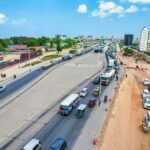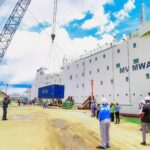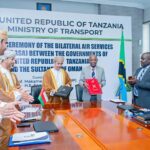Unlocking Prosperity: The Transformative Impact of Tanzania’s Nsalaga-Ifisi Road Expansion Project
In the heart of southern Tanzania, the Nsalaga-Ifisi road expansion project in Mbeya City is paving the way – both literally and figuratively – for a brighter, more connected future. As a key element of President Dr. Samia Suluhu Hassan’s Sixth Phase Government agenda, this ambitious infrastructure initiative highlights the vital role of roads in promoting economic growth, enhancing connectivity, and improving livelihoods. Minister Abdallah Ulega has issued directives to accelerate construction through round-the-clock operations, increased manpower, and enhanced equipment deployment. The project aims to address decades-old challenges such as congestion, poor road conditions, and limited access to essential services.
This 29-kilometre stretch is more than just asphalt and tarmac; it represents hope for farmers transporting their harvests, traders expanding their markets, and families accessing healthcare and education. The project is backed by a robust financial commitment of 35 billion Tanzanian shillings and exemplifies Tanzania’s dedication to sustainable development, regional integration and inclusive growth. The Nsalaga-Ifisi road project is a prime example of a holistic approach to infrastructure development. It has been designed to reduce travel times and boost agricultural exports, while also fostering environmental resilience and empowering local communities.
However, the process is not without its challenges. Critics have raised valid concerns about maintaining quality amidst expedited timelines, ensuring worker welfare during demanding shifts, and mitigating environmental impacts. By adhering to engineering best practices, prioritising transparency, and engaging stakeholders at every step, Tanzania sets a benchmark for excellence that could inspire transformative projects nationwide.
As the sun rises over Mbeya’s undulating hills, the hum of machinery and the determination of workers signal a new era for the region and the nation as a whole. This article provides an in-depth analysis of the strategic importance, anticipated outcomes, potential challenges and broader implications of the Nsalaga-Ifisi road expansion project. It offers insights into how this significant project is transforming lives and redefining progress in Tanzania. We warmly invite you to join us as we explore what it truly means to build pathways to prosperity — not just for today, but for generations to come.
-
The Strategic Importance of the Nsalaga-Ifisi Road
In the verdant landscapes of Mbeya City, a region renowned for its agricultural richness and burgeoning urban centres, the Nsalaga-Ifisi road stands as a lifeline that connects people, goods, and opportunities. This 29-kilometre stretch is far more than a mere ribbon of asphalt; it is a vital artery that sustains the socio-economic fabric of southern Tanzania. As the nation continues to embrace its Sixth Phase Government’s vision of sustainable development under President Dr. Samia Suluhu Hassan, the strategic importance of this road cannot be overstated.
Bridging Urban and Rural Realities
The Nsalaga-Ifisi road serves as a critical juncture between Mbeya City’s bustling urban core and the surrounding rural hinterlands. For farmers cultivating maize, coffee, and other cash crops in the fertile outskirts, this road provides their only viable route to reach markets within the city and beyond. Without reliable access, these producers face significant hurdles in transporting perishable goods, leading to post-harvest losses and diminished incomes. By improving connectivity, the expanded road will reduce travel times and ensure that produce reaches buyers in optimal condition, thereby bolstering agricultural productivity and livelihoods.
Moreover, the road acts as a conduit for urban residents seeking fresh produce, traditional crafts, and other goods sourced from rural areas. This symbiotic relationship underscores the interdependence of urban and rural economies—a dynamic that the upgraded Nsalaga-Ifisi road is poised to strengthen significantly.
Facilitating Trade and Commerce
Beyond local trade, the Nsalaga-Ifisi road plays a pivotal role in regional commerce. Mbeya City, often referred to as Tanzania’s “breadbasket,” supplies a substantial portion of the country’s food exports. However, inefficient transport infrastructure has historically constrained traders’ ability to capitalise on these resources fully. Delays caused by poor road conditions have led to increased operational costs and reduced competitiveness in both domestic and international markets.
With the ongoing expansion project, the road will accommodate heavier traffic volumes and smoother transit, enabling businesses to operate more efficiently. Trucks carrying agricultural products, construction materials, and manufactured goods will experience fewer bottlenecks, reducing fuel consumption and delivery times. Such improvements are expected to stimulate economic activity along the corridor, attracting new investments and fostering job creation in sectors ranging from logistics to retail.
Access to Essential Services
For many Tanzanians living in rural areas, accessing essential services such as healthcare and education remains a daunting challenge. The current state of the Nsalaga-Ifisi road exacerbates this issue, particularly during the rainy season, when sections of the road become impassable. Pregnant women requiring urgent medical attention, students commuting to schools, and families in need of basic amenities often find themselves stranded or forced to take prohibitively expensive detours.
The planned upgrades promise to transform this reality. A well-paved, all-weather road will ensure year-round accessibility, allowing emergency vehicles to reach remote communities swiftly and enabling children to attend school without enduring gruelling journeys. Improved mobility will also facilitate outreach programmes, bringing healthcare workers, teachers, and government officials closer to those who need them most.
Supporting Regional Integration
On a broader scale, the Nsalaga-Ifisi road contributes to Tanzania’s efforts to enhance regional integration. Mbeya City lies near the borders of Malawi and Zambia, making it a gateway for cross-border trade. Upgrading this road aligns with national and international initiatives aimed at streamlining transportation networks across East and Southern Africa. Enhanced connectivity will position Mbeya as a hub for regional commerce, further solidifying Tanzania’s role in promoting economic cooperation and shared prosperity.
A Symbol of Progress and Resilience
Ultimately, the Nsalaga-Ifisi road embodies more than practical utility—it symbolises progress and resilience. It represents the aspirations of countless Tanzanians striving for better lives, whether through improved farming yields, expanded business opportunities, or greater access to essential services. In a nation where infrastructure development is considered a cornerstone of sustainable growth, this road exemplifies how thoughtful investment can yield transformative outcomes.
As Minister Abdallah Ulega pushes for accelerated completion of the project, the emphasis on quality and durability must remain paramount. After all, what good is speed if the foundation crumbles under pressure? When completed, the Nsalaga-Ifisi road will not merely connect places—it will connect dreams, ambitions, and futures, paving the way for a brighter tomorrow in Mbeya City and beyond.
-
Current Challenges Faced by Commuters and Businesses
In the vibrant yet bustling environment of Mbeya City, the Nsalaga-Ifisi road has long been a double-edged sword for its residents and businesses. While it serves as a lifeline connecting urban centres to rural communities, its current state—characterised by traffic congestion, deteriorating road conditions, and frequent delays—has become a significant impediment to productivity and economic activity. These challenges are not merely inconveniences; they represent tangible barriers to progress that affect the daily lives of thousands of Tanzanians.
The Plight of Daily Commuters
For commuters in Mbeya City, navigating the Nsalaga-Ifisi road is often an exercise in patience and endurance. During peak hours, the road transforms into a cacophony of honking horns, idling vehicles, and frustrated drivers. Traffic jams stretch for kilometres, leaving passengers stranded for hours on what should be a relatively short journey. This congestion is exacerbated by the road’s narrow width and lack of proper drainage systems, which lead to waterlogging during the rainy season and further bottlenecks.
Public transport users bear the brunt of these delays. Dala-dalas (minibuses) and bajajis (three-wheeled rickshaws), the backbone of local transportation, frequently break down or get stuck in potholes, forcing passengers to disembark and seek alternative routes. For workers commuting to jobs in the city centre or students heading to school, these disruptions result in tardiness, missed opportunities, and heightened stress levels. In a country where time is money, such inefficiencies translate directly into lost income and diminished quality of life.
Struggles for Farmers and Traders
The adverse effects of the road’s poor condition extend far beyond urban commuters, deeply impacting the livelihoods of farmers and traders who rely on the Nsalaga-Ifisi road to move goods. For instance, smallholder farmers transporting maize, coffee, or bananas from rural villages to markets in Mbeya City face numerous obstacles. Potholes and uneven surfaces damage vehicles, increasing repair costs and reducing their capacity to carry larger loads. Delays caused by traffic congestion mean that perishable goods often spoil before reaching buyers, leading to financial losses and discouraging investment in agriculture.
Similarly, traders operating along the corridor encounter logistical nightmares. Trucks carrying construction materials, fuel, or manufactured products must contend with slow-moving traffic and frequent breakdowns. The resulting delays disrupt supply chains, inflate operational costs, and erode profit margins. For businesses striving to remain competitive in both local and regional markets, these inefficiencies are unsustainable and stifle growth.
Economic Costs of Poor Infrastructure
The broader economic implications of the road’s poor state cannot be ignored. According to studies conducted by Tanzanian economists, inadequate infrastructure can reduce GDP growth by up to 2% annually due to inefficiencies in transportation and logistics. In the case of the Nsalaga-Ifisi road, the cumulative effect of traffic congestion, vehicle damage, and delayed deliveries translates into millions of shillings in lost revenue each year.
Businesses that depend on timely delivery of raw materials and finished goods are particularly vulnerable. For example, manufacturers in Mbeya City may struggle to meet production targets if key inputs arrive late, while retailers risk losing customers if shelves remain empty due to supply chain disruptions. These ripple effects undermine not only individual enterprises but also the region’s overall economic potential.
Environmental and Safety Concerns
Beyond economic losses, the road’s deteriorating condition poses significant environmental and safety risks. Dust storms generated by unpaved sections degrade air quality, contributing to respiratory illnesses among nearby residents. Meanwhile, poorly lit stretches and sharp bends increase the likelihood of accidents, endangering motorists, cyclists, and pedestrians alike.
During the rainy season, the situation worsens as sections of the road become impassable due to flooding. Vehicles attempting to navigate these treacherous conditions often get stuck, requiring costly towing services or causing multi-hour delays. Such incidents not only strain emergency response resources but also heighten the risk of injuries and fatalities.
A Barrier to Social Development
Perhaps most troubling is how the road’s deficiencies hinder access to essential services. Healthcare facilities, schools, and government offices located along the corridor are rendered less accessible when travel becomes unreliable. Pregnant women seeking prenatal care, children attending distant schools, and families in need of urgent medical attention all face daunting journeys fraught with uncertainty. These challenges disproportionately affect vulnerable populations, perpetuating cycles of poverty and inequality.
Voices from the Ground
Local voices paint a vivid picture of the struggles faced daily. “Every morning feels like a battle,” says Juma Mwakalinga, a dala-dala driver who ferries passengers between Mbeya City and Ifisi. “We spend more time stuck in traffic than actually driving. Passengers complain, but what can we do? The road is falling apart.” Similarly, Fatima Omari, a farmer from Itete village, laments, “Half my harvest rots before I even reach the market. If only the road were better, I could sell more and provide for my family.”
These anecdotes underscore the human dimension of the problem—a reminder that behind every statistic lies a story of hardship and resilience.
An Urgent Need for Action
The challenges facing commuters and businesses along the Nsalaga-Ifisi road highlight the urgent need for intervention. As Minister Abdallah Ulega rightly emphasises, accelerating the pace of construction is not just about meeting deadlines—it is about addressing the profound impact that poor infrastructure has on people’s lives. By upgrading this vital artery, Tanzania can unlock new opportunities for growth, improve living standards, and lay the groundwork for a more prosperous future.
Roads represent more than just physical structures; they are conduits of hope and progress. For Mbeya City’s residents and businesses, the transformation of the Nsalaga-Ifisi road represents an opportunity to overcome the daily challenges of congestion, delays and uncertainty, and to create a foundation for a more prosperous and connected future.
-
Minister Ulega’s Directive: A Call to Action
In a bold and decisive move, Abdallah Ulega, Tanzania’s Minister for Works, has issued a directive to CHICO Company, the contractor overseeing the Nsalaga-Ifisi road expansion project in Mbeya City, that underscores the urgency of completing this critical infrastructure development. The directive is not merely an administrative order, but a rallying cry aimed at accelerating progress and addressing the mounting challenges faced by residents, businesses, and the broader economy. By calling for round-the-clock operations, increased manpower, and enhanced equipment deployment, Minister Ulega has set a clear roadmap for transforming the Nsalaga-Ifisi road into a modern, efficient artery that can meet the demands of 21st-century Tanzania.
Round-the-Clock Operations: A Race Against Time
At the heart of Minister Ulega’s directive is the call for CHICO Company to adopt a 24-hour work schedule. This measure reflects the pressing need to expedite construction while minimising delays caused by traditional daytime-only operations. In Mbeya City, where every day of inaction translates into lost opportunities—whether for farmers unable to transport their goods or commuters stuck in endless traffic—the decision to work around the clock is both pragmatic and necessary.
Round-the-clock operations will allow contractors to maximise productivity, particularly during off-peak hours when disruptions from traffic and public use are minimal. For instance, asphalt laying and heavy machinery tasks, which require precision and uninterrupted focus, can be executed more efficiently under these conditions. Moreover, working at night reduces the likelihood of conflicts with daily commuters, ensuring that the project proceeds without exacerbating existing congestion issues.
While some may question the feasibility of such an approach, citing concerns about worker fatigue and safety, Minister Ulega has made it clear that these challenges must be addressed through proper planning and resource allocation. Adequate rest periods, enhanced safety protocols, and the provision of protective gear will be non-negotiable requirements to ensure that workers remain healthy and motivated throughout the extended shifts.
Increased Manpower: Mobilising Human Capital
Another cornerstone of Ulega’s directive is the demand for an increase in manpower. Recognising that the scale and complexity of the Nsalaga-Ifisi road project require a robust workforce, CHICO Company has been instructed to recruit additional skilled labourers, engineers, and support staff. This surge in human capital is essential for tackling multiple segments of the road simultaneously, thereby shortening the overall timeline for completion.
The emphasis on increased manpower is particularly significant given the diverse range of tasks involved in road construction. From excavation and drainage system installation to paving and signage placement, each phase demands specialised expertise. By expanding the workforce, CHICO Company can address bottlenecks more effectively, ensuring that no single component of the project becomes a drag on overall progress. Furthermore, hiring locally wherever possible aligns with the government’s commitment to creating employment opportunities and empowering Tanzanian communities.
However, increasing manpower alone is insufficient if coordination and supervision are lacking. To this end, Minister Ulega has stressed the importance of rigorous oversight and communication channels within the team. Regular briefings, transparent reporting mechanisms, and accountability frameworks will be implemented to ensure that all hands are working toward the same goal: delivering a high-quality road within the stipulated timeframe.
Enhanced Equipment Deployment: Leveraging Technology
Minister Ulega’s directive also underscores the need for enhanced equipment deployment—a move designed to complement the expanded workforce and facilitate faster execution of tasks. Modern road construction relies heavily on advanced machinery, including bulldozers, graders, pavers, and rollers. Without sufficient equipment, even the most skilled workforce would struggle to achieve meaningful progress.
By mandating the deployment of additional machinery, Ulega aims to streamline processes and reduce manual labour where possible. For example, mechanised grading and asphalt laying not only improve efficiency but also enhance the durability and uniformity of the road surface. Similarly, deploying lighting systems and generators for nighttime operations ensures that visibility and productivity remain consistent regardless of the hour.
Critics might argue that acquiring new equipment could strain financial resources or lead to logistical complications. However, given the Sixth Phase Government’s allocation of 35 billion shillings to the project, there is ample justification for investing in state-of-the-art tools. Moreover, the long-term benefits of using durable materials and cutting-edge technology far outweigh the initial costs, as they contribute to a longer lifespan for the road and reduced maintenance expenses down the line.
Why Such Measures Are Deemed Necessary
The necessity of these measures stems from two overarching factors: the urgent need to alleviate current hardships and the strategic importance of the Nsalaga-Ifisi road to Tanzania’s development agenda. On one hand, the road’s deteriorating condition has become a daily ordeal for commuters, traders, and farmers, undermining economic activity and social well-being. Traffic congestion and frequent breakdowns have turned what should be a convenient route into a source of frustration and inefficiency.
On the other hand, the Nsalaga-Ifisi road is a linchpin in Tanzania’s efforts to foster regional connectivity, boost agricultural exports, and attract foreign investment. Under President Dr. Samia Suluhu Hassan’s leadership, the government has prioritised infrastructure development as a catalyst for sustainable growth. Delaying the completion of this project would not only hinder Mbeya City’s progress but also impede national objectives tied to industrialisation, trade facilitation, and poverty alleviation.
Furthermore, the directive sends a powerful message about accountability and transparency. By holding CHICO Company to a higher standard of performance, Minister Ulega reinforces the principle that taxpayer funds must yield tangible results. The allocation of 35 billion shillings represents a significant investment in Tanzania’s future, and the public rightly expects timely delivery of a project that promises transformative outcomes.
A Symbol of Commitment and Resolve
Minister Ulega’s directive is more than a set of instructions—it is a symbol of unwavering commitment to the people of Mbeya City and Tanzania as a whole. It reflects an understanding that infrastructure is not just about concrete and steel; it is about building pathways to prosperity, opportunity, and resilience. By calling for round-the-clock operations, increased manpower, and enhanced equipment deployment, Ulega has laid out a blueprint for success that balances ambition with practicality.
As the sun rises over Mbeya’s rolling hills, the hum of machinery and the sight of workers toiling day and night serve as reminders of what collective effort can achieve. With steadfast determination and meticulous execution, the Nsalaga-Ifisi road expansion project will soon stand as a testament to Tanzania’s vision of progress—one pothole-filled stretch transformed into a smooth, unbroken ribbon of hope.
Roads are pivotal in connecting places and shaping futures. Following the directive issued by Minister Ulega, Tanzania has reaffirmed its commitment to addressing the disparities between urban and rural areas, as well as the gap between the present challenges and future opportunities.
-
Progress So Far: Reaching 25 Percent Completion
As the Nsalaga-Ifisi road expansion project in Mbeya City advances, it has reached a notable milestone: 25 percent completion. This significant progress reflects both the dedication of CHICO Company and the unwavering oversight of Minister Abdallah Ulega, who recently expressed measured satisfaction with the initial implementation phase during his on-site inspection. While this achievement is commendable, it also serves as a reminder that much work remains to be done. Sustaining momentum will be critical to ensuring the timely delivery of a road that promises to transform lives, economies, and communities across southern Tanzania.
A Quarter Done, but Miles to Go
The 25 percent completion mark represents tangible progress in what is undoubtedly one of Mbeya City’s most anticipated infrastructure projects. Key milestones achieved so far include the excavation and levelling of several sections of the road, installation of drainage systems in flood-prone areas, and preliminary paving work along select stretches. These accomplishments are visible indicators of forward motion, offering hope to residents and businesses weary of the road’s current state.
Minister Ulega acknowledged these efforts during his visit, praising CHICO Company for adhering to technical specifications and maintaining quality standards despite challenges such as adverse weather conditions and logistical constraints. “We have seen steady progress,” he remarked, “and I am pleased with how far we have come. However, let us not rest on our laurels—we must push harder to complete this vital artery for the people of Mbeya.”
His words underscore a crucial point: reaching the quarter-way stage is no cause for complacency. With three-quarters of the project still ahead, there is an urgent need to maintain—and even accelerate—the pace of construction to meet the ambitious timelines set by the Sixth Phase Government under President Dr. Samia Suluhu Hassan.
Visible Improvements on the Ground
For residents of Mbeya City, the early signs of progress are more than just numbers; they are real-world changes beginning to take shape. Farmers transporting maize and coffee from rural villages report fewer instances of vehicles getting stuck in mud, thanks to improved drainage systems installed along previously flooded sections. Commuters, too, have noticed smoother travel on newly paved stretches, reducing journey times and vehicle wear-and-tear.
Local business owners, particularly those involved in logistics and trade, are cautiously optimistic about the potential impact of these developments. “I can already see some improvement,” said Mwajuma Kibona, owner of a small transport company based in Mbeya. “My trucks aren’t breaking down as often, and deliveries are faster. But we’re waiting for the full road to open before we celebrate.”
These testimonials highlight the transformative power of infrastructure—even partial upgrades can yield immediate benefits. Yet, they also reinforce the importance of completing the remaining 75 percent to unlock the road’s full potential.
Challenges Overcome—and Those Still Ahead
Reaching 25 percent completion has not been without its hurdles. The rainy season posed significant challenges, washing away some excavated sections and delaying paving activities. Equipment shortages and occasional disputes over land acquisition further complicated matters. Despite these obstacles, CHICO Company demonstrated adaptability, deploying additional machinery and reallocating resources to keep the project on track.
However, the road ahead is fraught with new challenges. Expanding operations to cover all 29 kilometres of the road requires meticulous planning and coordination. Ensuring consistent quality while accelerating timelines demands rigorous supervision and adherence to engineering best practices. Moreover, working round-the-clock introduces risks related to worker fatigue and safety, necessitating robust measures to protect the workforce.
Minister Ulega has made it clear that overcoming these challenges will require sustained effort and collaboration. “Progress is good, but perfection is better,” he stated. “We cannot afford shortcuts or compromises at this stage. Every kilometre we build must stand the test of time.”
The Need for Continued Public Support
Public support plays a pivotal role in sustaining momentum. Community engagement has been a cornerstone of the project’s success thus far, with local leaders and stakeholders actively participating in consultations and problem-solving initiatives. For example, villagers along the corridor have assisted in identifying alternative routes during construction, minimising disruptions to daily life. Such cooperation fosters goodwill and ensures that the project aligns with community needs.
To maintain this positive relationship, transparency, and communication remain essential. Regular updates on progress, coupled with opportunities for feedback, help build trust and mitigate concerns about delays or inconveniences. Minister Ulega encouraged residents to continue supporting the project, reminding them that their patience and contributions are integral to its ultimate success.
A Blueprint for Future Projects
The Nsalaga-Ifisi road expansion project serves as a litmus test for Tanzania’s broader infrastructure agenda. By achieving 25 percent completion within the allocated timeframe, CHICO Company and the Ministry of Works has demonstrated the feasibility of large-scale development initiatives when executed with discipline and determination. Lessons learned from this phase—such as the importance of adaptive strategies, stakeholder involvement, and resource optimisation—can inform future projects nationwide.
Moreover, the project exemplifies the Sixth Phase Government’s commitment to delivering results. The allocation of 35 billion shillings underscores the administration’s prioritisation of infrastructure as a driver of economic growth and social development. Each metre of asphalt laid brings Tanzania closer to realising its vision of becoming a regional hub for trade, investment, and innovation.
Looking Forward: From Promise to Reality
While reaching 25 percent completion is a laudable achievement, it is merely the foundation upon which greater successes must be built. The coming months will demand relentless focus, innovative solutions, and unyielding resolve to navigate the complexities of scaling up operations. Minister Ulega’s directive to accelerate construction through round-the-clock shifts, increased manpower, and enhanced equipment deployment provides a clear pathway forward—but execution will determine whether the promise of transformation becomes a reality.
As dusk falls over Mbeya City, the sight of workers illuminated by floodlights and the sound of machinery humming in the distance serve as reminders of the collective effort driving this monumental undertaking. With each passing day, the Nsalaga-Ifisi road inches closer to completion, carrying with it the hopes and aspirations of countless Tanzanians.
Progress is a journey, not a destination. At 25 percent completion, the Nsalaga-Ifisi road demonstrates the potential for achieving significant progress through perseverance and collaboration. However, the true measure of success will be seen in seeing this journey through to its conclusion – a fully functional road that connects people, propels economies and paves the way to a brighter future.
-
Financial Commitment from the Sixth Phase Government
The allocation of 35 billion Tanzanian shillings towards the Nsalaga-Ifisi road expansion project is more than a financial transaction—it is a bold statement of intent. This significant investment underscores President Dr. Samia Suluhu Hassan’s unwavering commitment to prioritising infrastructure development as a cornerstone of Tanzania’s socio-economic transformation. Under her leadership, the Sixth Phase Government has embraced a forward-thinking vision that positions infrastructure as a catalyst for sustainable growth, regional integration, and improved living standards. The funding earmarked for this project reflects fiscal responsibility and signals a strategic shift in how Tanzania approaches its development priorities.
A Testament to Visionary Leadership
President Dr. Samia Suluhu Hassan’s administration has consistently championed infrastructure development as one of its key pillars, recognising it as an enabler of progress across multiple sectors. From agriculture and trade to education and healthcare, reliable infrastructure forms the backbone of any thriving economy. By committing 35 billion shillings to the Nsalaga-Ifisi road expansion, the government demonstrates its understanding that roads are not merely physical structures—they are conduits of opportunity, connecting people to markets, services, and dreams.
This financial commitment aligns with the broader objectives outlined in Tanzania’s Development Vision 2025, which seeks to create a semi-industrialised nation characterised by robust connectivity and modernised transport networks. The Nsalaga-Ifisi road, in Mbeya City—a region often referred to as Tanzania’s “breadbasket”—is a prime example of how targeted investments can yield exponential returns. Improved connectivity will enhance agricultural exports, attract foreign direct investment, and stimulate local entrepreneurship, thereby contributing to national GDP growth.
Maximising Returns on Investment
The decision to allocate 35 billion shillings to this project is rooted in a cost-benefit analysis that considers both immediate and long-term impacts. For every shilling spent on upgrading the Nsalaga-Ifisi road, the potential economic dividends are substantial. Farmers transporting maize, coffee, and bananas to urban markets will experience reduced post-harvest losses, while businesses reliant on timely deliveries will see their operational costs decrease. Additionally, the improved road will reduce vehicle maintenance expenses for commuters and freight operators, freeing up capital for other productive uses.
Moreover, the ripple effects of this investment extend beyond direct beneficiaries. Enhanced mobility will facilitate access to essential services such as healthcare and education, empowering communities along the corridor. It will also support Tanzania’s aspirations for regional integration, enabling seamless movement of goods and people between Mbeya City and neighbouring countries like Malawi and Zambia. In essence, the 35 billion shillings represent seed money for a multiplier effect that could reshape southern Tanzania’s economic landscape.
Addressing Historical Gaps
The allocation of funds also speaks to the government’s recognition of historical gaps in infrastructure development. For decades, many rural areas in Tanzania have suffered from inadequate roads, limiting their ability to participate fully in the national economy. The Nsalaga-Ifisi road has long been emblematic of these challenges, with its deteriorating condition stifling growth and exacerbating inequalities. By addressing this issue head-on, President Hassan’s administration is sending a clear message: no region should be left behind in Tanzania’s march toward prosperity.
The choice of Mbeya City as a focal point for such investment is particularly significant. As one of Tanzania’s fastest-growing regions, Mbeya serves as a microcosm of the country’s developmental aspirations. Its fertile lands, burgeoning industries, and strategic location make it a natural hub for economic activity. Upgrading the Nsalaga-Ifisi road ensures that this potential is fully harnessed, benefiting not just Mbeya but the entire nation.
Accountability and Transparency
With great investment comes great responsibility. Recognising this, Minister Abdallah Ulega has emphasised the importance of accountability in utilising the 35 billion shillings allocated to the project. Every penny must be accounted for, and CHICO Company—the contractor overseeing construction—has been instructed to adhere strictly to budgetary guidelines and technical specifications. Regular audits and transparent reporting mechanisms will ensure that the funds are used efficiently and effectively.
This emphasis on transparency resonates deeply with Tanzanians, who have grown weary of past instances where mismanagement undermined public trust. By prioritising oversight and accountability, the Sixth Phase Government aims to restore confidence in its ability to deliver tangible results. The successful execution of the Nsalaga-Ifisi road project will serve as a benchmark for future initiatives, reinforcing the idea that taxpayer money is being spent wisely.
Aligning with Global Best Practices
The financial commitment to the Nsalaga-Ifisi road also places Tanzania within the global context of infrastructure-led development. Across Africa, nations are increasingly recognising the transformative power of well-planned and adequately funded projects. Ethiopia’s Addis Ababa-Djibouti railway, Kenya’s Standard Gauge Railway, and Rwanda’s Kigali Urban Roads Project are all examples of how strategic investments can drive progress. By allocating 35 billion shillings to upgrade a critical artery like the Nsalaga-Ifisi road, Tanzania joins this league of proactive governments committed to building modern, resilient economies.
Furthermore, the project aligns with international frameworks such as the African Union’s Agenda 2063, which calls for integrated infrastructure networks to foster intra-African trade and cooperation. As Tanzania positions itself as a gateway to East and Southern Africa, projects like the Nsalaga-Ifisi road become vital links in a larger continental tapestry.
Empowering Local Economies
At its core, the 35 billion shilling allocation is about empowerment. It empowers farmers to reach wider markets, traders to expand their operations, and families to access better opportunities. It empowers Mbeya City to fulfil its role as an economic powerhouse and empowers Tanzania to take its rightful place on the global stage. But perhaps most importantly, it empowers ordinary citizens to believe in the possibility of change—a belief that lies at the heart of President Hassan’s leadership philosophy.
By investing in the Nsalaga-Ifisi road, the Sixth Phase Government is investing in people. Each layer of asphalt laid represents a step closer to achieving the dreams of countless Tanzanians who yearn for a brighter future. And as the road takes shape under the watchful eyes of engineers, workers, and stakeholders, so too does a new narrative—one of hope, resilience, and boundless potential.
The allocation of 35 billion shillings to the Nsalaga-Ifisi road expansion project is not just a line item in a budget; it is a clear commitment to the future of Tanzania. This investment is a clear indication of President Dr. Samia Suluhu Hassan’s commitment to creating a nation where every individual has the tools and opportunities needed to succeed. As construction of the road approaches completion, it will serve as a testament to the power of visionary leadership, prudent financial management, and collective effort, paving the way to shared prosperity and a lasting legacy.
-
Expected Outcomes: Economic Growth and Improved Livelihoods
The completion of the Nsalaga-Ifisi road expansion project in Mbeya City is poised to deliver transformative benefits that extend far beyond the physical act of paving a roadway. By addressing decades-old challenges such as congestion, poor road conditions, and limited connectivity, this initiative promises to catalyse economic growth, enhance livelihoods, and improve safety for all users. The anticipated outcomes are multifaceted, touching every aspect of life in southern Tanzania—from bustling urban centres to remote rural villages. Below, we explore these expected benefits in detail.
1. Reduced Travel Times: A Boost to Efficiency
One of the most immediate and tangible impacts of the completed road will be the significant reduction in travel times. Currently, commuters and freight operators face hours-long delays due to potholes, narrow lanes, and frequent traffic jams. Once upgraded, the expanded Nsalaga-Ifisi road will feature wider lanes, proper drainage systems, and durable asphalt, allowing vehicles to move swiftly and smoothly.
For instance, a journey that once took two hours may be reduced to just thirty minutes, enabling workers to reach their jobs on time, students to attend school without interruption, and emergency services to respond more quickly. This efficiency will save time and reduce fuel consumption—a critical consideration given the rising cost of petrol and diesel in Tanzania. Businesses, too, will benefit from faster deliveries, cutting operational costs and enhancing competitiveness.
2. Increased Agricultural Exports: Unlocking Mbeya’s Potential
Mbeya City is often hailed as Tanzania’s “breadbasket,” thanks to its fertile soils and favourable climate for growing crops such as maize, coffee, bananas, and beans. However, farmers have long struggled to capitalise on this agricultural bounty due to inadequate transport infrastructure. The current state of the Nsalaga-Ifisi road forces them to navigate treacherous paths, risking damage to produce and delays that render perishable goods unsellable.
With the new road in place, farmers will enjoy seamless access to markets both within Mbeya and beyond. Fresh produce can be transported to urban centres or exported to neighbouring countries like Malawi and Zambia with minimal spoilage. Increased access to regional and international markets will incentivise higher yields and better farming practices, ultimately boosting agricultural exports. This surge in productivity could position Mbeya as a key player in Tanzania’s efforts to become a net exporter of food commodities, contributing significantly to national GDP and foreign exchange earnings.
3. Improved Safety for Motorists and Pedestrians
Safety has been a persistent concern along the Nsalaga-Ifisi road, where poorly lit stretches, sharp bends, and uneven surfaces have led to numerous accidents over the years. These incidents have claimed lives, injured countless individuals, and imposed heavy financial burdens on families and healthcare systems. The upgraded road will incorporate modern safety features, including well-marked lanes, reflective signage, pedestrian crossings, and adequate lighting.
Additionally, improved drainage systems will mitigate flooding during the rainy season, reducing the likelihood of vehicles skidding or becoming stranded. For pedestrians, especially children walking to school and women carrying goods to the market, safer pathways mean fewer risks and greater peace of mind. By prioritising safety, the project aligns with global best practices in road design and reflects the Sixth Phase Government’s commitment to protecting human life.
4. Enhanced Access to Essential Services
Access to essential services such as healthcare, education, and government offices is a fundamental right—but one that remains out of reach for many living along the Nsalaga-Ifisi corridor. The current road conditions make it difficult for ambulances to reach patients in emergencies, for teachers to commute to rural schools, and for families to visit clinics or administrative centres.
Once completed, the road will ensure year-round accessibility, regardless of weather conditions. Pregnant women requiring urgent medical attention will no longer face perilous journeys; children attending distant schools will arrive safely and on time; and entrepreneurs seeking permits or licences will find it easier to interact with local authorities. These improvements will foster social equity, ensuring that even the most marginalised communities can access the resources they need to thrive.
5. Job Creation and Economic Opportunities
Infrastructure projects like the Nsalaga-Ifisi road expansion are powerful engines of job creation. During the construction phase alone, hundreds of Tanzanians have been employed as labourers, engineers, supervisors, and support staff. Many of these jobs have gone to locals, providing much-needed income and skills development opportunities. Beyond construction, the completed road will stimulate further employment by attracting businesses to the area.
For example, improved connectivity will encourage investors to establish warehouses, processing plants, and retail outlets along the corridor. Small-scale traders and service providers—such as mechanics, restaurants, and lodges—will also see increased patronage as traffic volumes rise. This multiplier effect will create a virtuous cycle of economic activity, lifting entire communities out of poverty and fostering self-reliance.
6. Environmental Benefits: Reducing Emissions and Dust Pollution
While roads are often associated with environmental degradation, the Nsalaga-Ifisi road expansion includes measures to minimise its ecological footprint. The existing dirt tracks generate massive amounts of dust during the dry season, degrading air quality and posing health risks to nearby residents. Similarly, idling vehicles stuck in traffic contribute to unnecessary carbon emissions.
By paving the road and streamlining traffic flow, the project will drastically reduce dust pollution and vehicle idling. Cleaner air will lead to healthier communities, particularly for those suffering from respiratory ailments. Furthermore, smoother surfaces will lower fuel consumption, contributing to a reduction in greenhouse gas emissions. These environmental gains underscore the importance of sustainable infrastructure development in achieving broader climate goals.
7. Strengthening Regional Integration
Mbeya City’s strategic location near Tanzania’s borders with Malawi and Zambia makes it a gateway for cross-border trade. The Nsalaga-Ifisi road serves as a vital link in this network, facilitating the movement of goods between East and Southern Africa. With the upgraded road, transit times for trucks carrying imports and exports will decrease substantially, making Mbeya an attractive hub for logistics companies and traders.
This enhanced connectivity supports Tanzania’s ambitions under the African Continental Free Trade Area (AfCFTA), which seeks to boost intra-African trade by dismantling barriers to movement. As part of this vision, the Nsalaga-Ifisi road will play a crucial role in integrating Mbeya into regional supply chains, driving economic cooperation and shared prosperity across borders.
8. Empowering Women and Youth
Infrastructure projects have a unique ability to empower vulnerable groups, including women and youth. In rural areas along the Nsalaga-Ifisi corridor, women often bear the brunt of poor road conditions when transporting goods to market or seeking healthcare services. The upgraded road will ease these burdens, enabling women to participate more fully in economic activities and improving their quality of life.
Similarly, young people stand to gain from the influx of jobs and entrepreneurial opportunities created by the project. Whether through formal employment during construction or informal ventures post-completion, the road will open doors for Tanzania’s largest demographic group. By investing in infrastructure, the government is indirectly investing in the future leaders of the nation.
9. Building Resilience Against Climate Shocks
Climate change poses significant threats to infrastructure, particularly in regions prone to heavy rainfall and flooding. The Nsalaga-Ifisi road expansion incorporates resilient design principles, such as elevated embankments and reinforced drainage systems, to withstand extreme weather events. These adaptations will protect the road from damage caused by seasonal rains, ensuring its longevity and reliability.
Such resilience is critical for sustaining economic activity in Mbeya City, where agriculture—the backbone of the local economy—is highly sensitive to climatic variability. A durable road means farmers can continue to transport their goods even during challenging weather conditions, safeguarding livelihoods and food security.
10. A Symbol of Progress and Hope
Above all, the Nsalaga-Ifisi road represents more than concrete and tarmac—it symbolises progress and hope. For the people of Mbeya City and surrounding areas, the sight of a smooth, well-paved road stretching toward the horizon is a reminder that their voices have been heard and their aspirations acknowledged. It embodies the promise of a brighter future, where obstacles are overcome, opportunities abound, and dreams become attainable.
President Dr. Samia Suluhu Hassan’s commitment to infrastructure development shines through in this project, reinforcing her administration’s dedication to improving the lives of ordinary Tanzanians. As Minister Abdallah Ulega oversees the final stages of construction, he carries with him the hopes of thousands who believe that a better tomorrow begins today—with a single, well-built road.
Roads are pivotal in connecting places and shaping futures. The Nsalaga-Ifisi road expansion project represents more than just an infrastructural upgrade; it is a vital source of economic growth, improved livelihoods and sustainable development. Upon completion, it will serve as a testament to the power of determination, collaboration, and visionary leadership in achieving significant progress for all Tanzanians, paving the way for a prosperous future.
-
Potential Challenges in Accelerating Construction
While the directive to accelerate the construction of the Nsalaga-Ifisi road expansion project in Mbeya City is commendable and necessary, it is not without its potential hurdles. The ambitious timeline set by Minister Abdallah Ulega—coupled with the call for round-the-clock operations, increased manpower, and enhanced equipment deployment—raises important questions about how these challenges will be addressed. Logistical constraints, environmental concerns, and the need to maintain quality despite an expedited schedule are among the key issues that must be carefully managed to ensure the project’s success. Below, we examine these challenges in detail and offer balanced perspectives on how they can be mitigated.
1. Logistical Constraints: Managing Supply Chains Under Pressure
One of the most pressing challenges facing CHICO Company is ensuring a steady supply of materials and equipment required for the accelerated pace of construction. Road projects of this scale demand vast quantities of asphalt, gravel, cement, and other raw materials, all of which must be sourced, transported, and delivered efficiently. Any disruption in the supply chain—whether due to shortages, transportation bottlenecks, or delays at ports—could derail progress.
For instance, Mbeya City’s location in southern Tanzania means that some materials may need to be transported over long distances from suppliers elsewhere in the country or even imported from abroad. The rainy season further complicates logistics, as flooded roads and washed-out bridges can hinder the movement of heavy machinery and materials. To address these logistical challenges, CHICO Company must adopt proactive measures such as:
- Establishing buffer stockpiles of critical materials near the construction site.
- Partnering with local suppliers to reduce reliance on distant sources.
- Developing contingency plans for alternative transport routes during adverse weather conditions.
Failure to manage these constraints effectively could lead to costly delays and undermine public confidence in the project.
2. Environmental Concerns: Balancing Progress with Sustainability
The rapid acceleration of construction poses significant environmental risks, particularly in a region like Mbeya City, which is renowned for its rich biodiversity and fertile landscapes. Deforestation, soil erosion, and water pollution are just a few of the potential consequences if environmental safeguards are not strictly enforced.
For example, excavating large sections of the road corridor can disturb natural habitats and disrupt ecosystems. Similarly, improper disposal of construction waste or run-off from asphalt-laying activities could contaminate nearby rivers and streams, threatening aquatic life and drinking water sources for local communities. These concerns are especially pertinent given Tanzania’s commitment to sustainable development under international frameworks such as the African Union’s Agenda 2063 and the United Nations’ Sustainable Development Goals (SDGs).
To mitigate these risks, CHICO Company must prioritise environmentally friendly practices throughout the construction process. This includes:
- Conducting thorough environmental impact assessments (EIAs) before commencing work in sensitive areas.
- Implementing erosion control measures, such as retaining walls and vegetative cover, to prevent soil degradation.
- Ensuring proper waste management protocols are followed to avoid contamination of air, water, and soil.
Minister Ulega has already stressed the importance of adhering to technical specifications, which should include environmental considerations. However, striking a balance between speed and sustainability remains a delicate task.
3. Ensuring Quality Despite Expedited Timelines
Perhaps the most significant challenge posed by the accelerated timeline is maintaining the quality of construction. Rushing projects often leads to shortcuts that compromise durability, resulting in premature deterioration and higher maintenance costs down the line. For a road expected to serve as a lifeline for Mbeya City’s economy, any lapses in quality could have devastating consequences.
Key areas of concern include:
- Material Standards: Ensuring that asphalt and other materials meet rigorous quality benchmarks, even when procured quickly.
- Workmanship: Avoiding errors caused by worker fatigue or inadequate supervision during extended shifts.
- Weather Resistance: Designing the road to withstand heavy rainfall, frequent use, and other stresses common in Tanzania’s climate.
To address these concerns, CHICO Company must implement robust quality assurance mechanisms, including regular inspections, independent audits, and adherence to international engineering standards. Training workers on best practices and providing them with adequate rest periods will also help minimise human error.
Minister Ulega’s insistence on accountability and transparency plays a crucial role here. By holding contractors accountable for substandard work, the government can ensure that the finished product reflects both urgency and excellence.
4. Worker Welfare and Safety Risks
Accelerating construction inherently increases the demands placed on workers, raising concerns about their welfare and safety. Working round-the-clock shifts exposes labourers to heightened risks of fatigue, accidents, and health issues, particularly in hazardous environments such as road construction sites.
For example, operating heavy machinery during nighttime hours requires exceptional vigilance, yet tired workers may struggle to maintain focus. Additionally, inadequate lighting or protective gear could exacerbate the likelihood of injuries. These risks are compounded by the fact that many workers may lack access to comprehensive healthcare or insurance coverage.
To safeguard workers, CHICO Company must prioritise occupational health and safety (OHS) protocols, including:
- Providing personal protective equipment (PPE) and ensuring its proper use.
- Rotating shifts regularly to prevent exhaustion and burnout.
- Offering medical facilities and emergency response teams on-site.
Addressing worker welfare is not only a moral imperative but also a practical necessity; healthy, motivated workers are more productive and less prone to mistakes that could jeopardise the project.
5. Community Disruptions and Social Tensions
The acceleration of construction activities inevitably disrupts daily life for residents and businesses along the Nsalaga-Ifisi corridor. Increased noise levels, dust pollution, and restricted access to certain sections of the road can strain relationships between contractors and the community. For instance, farmers who rely on the road to transport goods may face temporary blockades, while shopkeepers may see a decline in foot traffic due to detours.
To mitigate social tensions, CHICO Company must engage proactively with local stakeholders. Regular consultations, transparent communication about timelines and disruptions, and efforts to minimise inconvenience—such as creating alternative routes—can go a long way in building goodwill. Compensation for damages or losses incurred during construction may also be necessary in some cases.
Minister Ulega’s emphasis on community involvement aligns with this approach, highlighting the importance of viewing residents not as passive recipients of infrastructure but as active partners in its development.
6. Financial Management and Cost Overruns
Accelerating construction often comes with additional costs, whether due to overtime wages, expedited material procurement, or unforeseen complications. While the Sixth Phase Government has allocated 35 billion shillings to the project, there is always the risk of budget overruns if expenditures are not carefully monitored.
To prevent financial mismanagement, CHICO Company must adhere to strict budgetary controls and provide regular updates on spending. Independent oversight bodies could also play a role in ensuring that funds are used efficiently and transparently. Additionally, leveraging economies of scale—for example, by purchasing materials in bulk—can help keep costs under control.
7. Coordination Among Stakeholders
With multiple parties involved in the project—from government officials and contractors to local leaders and residents—effective coordination is essential to avoid conflicts and inefficiencies. Miscommunication or competing priorities can lead to delays, disputes, and suboptimal outcomes.
Establishing clear lines of communication and assigning dedicated liaison officers to mediate between stakeholders can help streamline decision-making processes. Regular progress meetings and shared platforms for information exchange will further enhance collaboration.
8. Long-Term Maintenance Planning
Finally, accelerating construction does not absolve the government or CHICO Company of their responsibility to plan for long-term maintenance. A hastily completed road that lacks proper upkeep will deteriorate quickly, negating the benefits of the initial investment. Therefore, provisions for routine repairs, resurfacing, and drainage system maintenance must be incorporated into the project’s design phase.
Engaging local authorities and communities in post-construction care can foster a sense of ownership and ensure the road remains functional for decades to come.
A Balanced Perspective
While the challenges outlined above are formidable, they are not insurmountable. With meticulous planning, stakeholder collaboration, and a steadfast commitment to quality and sustainability, CHICO Company and the Ministry of Works can overcome these hurdles. The acceleration of the Nsalaga-Ifisi road project reflects Tanzania’s determination to deliver results—but it also underscores the importance of balancing ambition with pragmatism.
By addressing logistical constraints, mitigating environmental impacts, safeguarding worker welfare, and fostering community engagement, the project can achieve its goals without compromising integrity or longevity. In doing so, it will not only transform the lives of Mbeya City’s residents but also serve as a model for future infrastructure initiatives across Tanzania.
Final Thought: Every great endeavour carries inherent risks, but it is the manner in which those risks are managed that defines success. The Nsalaga-Ifisi road expansion project represents a test of Tanzania’s ability to balance speed with quality, progress with sustainability, and aspiration with accountability. If navigated wisely, this journey will pave the way—not just literally—to a brighter, more connected future for all Tanzanians.
-
Community Engagement and Stakeholder Collaboration
In the context of infrastructure development, the success of a project is not solely determined by its technical achievements but also by how well it addresses the needs and aspirations of the people it serves. The Nsalaga-Ifisi road expansion project in Mbeya City offers an invaluable opportunity to demonstrate the power of community engagement and stakeholder collaboration in shaping outcomes that are both sustainable and equitable. By actively involving local communities, businesses, and other stakeholders in the planning and execution phases, CHICO Company and the Ministry of Works can ensure that the project delivers tangible benefits while fostering trust, ownership, and long-term resilience.
1. Understanding Local Needs Through Inclusive Planning
At the heart of effective community engagement lies the principle of inclusivity—ensuring that all voices, particularly those most affected by the project, are heard and considered. For the Nsalaga-Ifisi road expansion, this means consulting farmers, traders, commuters, and residents who rely on the road daily. Their insights provide critical context about specific pain points, such as recurring flooding in certain areas or frequent breakdowns near sharp bends.
For instance, smallholder farmers might highlight the need for improved drainage systems to prevent waterlogging during the rainy season, while traders could advocate for better lighting along sections prone to nighttime accidents. Incorporating these perspectives into the design phase ensures that the final product reflects real-world challenges rather than abstract assumptions.
Moreover, engaging women and youth—groups often marginalised in decision-making processes—is essential to creating solutions that benefit everyone. Women, for example, may prioritise safer pedestrian crossings to facilitate their journeys to markets, while young entrepreneurs might seek wider shoulders to accommodate roadside stalls. This participatory approach not only enhances the functionality of the road but also fosters a sense of inclusion and empowerment among diverse groups.
2. Building Trust Through Transparent Communication
Transparency is key to maintaining public confidence throughout the construction process. Residents and businesses along the corridor have already endured years of frustration due to the road’s poor condition; any delays or disruptions caused by the expansion project could exacerbate existing grievances if not properly communicated.
To build trust, CHICO Company and the Ministry of Works must adopt a proactive communication strategy. Regular updates on progress, timelines, and potential inconveniences should be shared through accessible channels, such as town hall meetings, radio broadcasts, and social media platforms. Clear signage at construction sites can also inform passersby about ongoing activities and expected completion dates.
Minister Abdallah Ulega’s recent inspection visit exemplifies the importance of visibility and accountability. By engaging directly with stakeholders on the ground, he reinforced the government’s commitment to transparency and responsiveness—a model that contractors should emulate throughout the project.
3. Mitigating Disruptions Through Collaborative Solutions
Infrastructure projects inevitably disrupt daily life, whether through restricted access, increased noise levels, or temporary closures. For businesses operating along the Nsalaga-Ifisi corridor, these disruptions can translate into lost revenue and strained operations. Farmers transporting produce, shopkeepers reliant on foot traffic, and service providers catering to travellers all face unique challenges during construction.
To mitigate these impacts, CHICO Company must collaborate closely with affected stakeholders to develop practical solutions. For example:
- Creating alternative routes for vehicles and pedestrians to minimise travel delays.
- Offering compensation or incentives to businesses experiencing significant losses.
- Scheduling noisy or disruptive activities during off-peak hours to reduce inconvenience.
Such measures demonstrate sensitivity to local concerns and help maintain goodwill throughout the project. When stakeholders feel that their interests are being prioritised, they are more likely to support the initiative—even amidst short-term hardships.
4. Empowering Local Leadership and Ownership
Local leaders—whether traditional elders, village chairpersons, or business association representatives—play a pivotal role in bridging the gap between communities and contractors. Their intimate knowledge of local dynamics makes them invaluable allies in identifying priorities, resolving conflicts, and mobilising support for the project.
By empowering these leaders to act as intermediaries, CHICO Company can foster stronger relationships with the community. For example, organising regular forums where local leaders can voice concerns and propose solutions creates a structured platform for dialogue. Similarly, involving them in monitoring progress and reporting issues helps ensure accountability and swift resolution of problems.
This collaborative approach also instils a sense of ownership among residents. When people see themselves as active participants in the development process—not just passive recipients—they are more likely to take pride in the finished product and contribute to its upkeep over time.
5. Leveraging Business Expertise for Economic Opportunities
The Nsalaga-Ifisi road expansion presents numerous opportunities for local businesses to thrive, from supplying materials and services to capitalising on increased traffic volumes post-completion. Engaging these enterprises early in the planning phase allows contractors to tap into indigenous expertise while boosting the local economy.
For instance, sourcing gravel, sand, and other raw materials from nearby quarries supports small-scale miners and reduces transportation costs. Similarly, partnering with local mechanics, fuel stations, and eateries to cater to workers’ needs generates immediate employment and revenue streams. Beyond construction, businesses stand to benefit from improved connectivity once the road is operational, attracting new customers and expanding market reach.
By fostering partnerships with local entrepreneurs, CHICO Company strengthens supply chains and demonstrates its commitment to inclusive growth—a cornerstone of President Dr. Samia Suluhu Hassan’s developmental agenda.
6. Promoting Environmental Stewardship Through Community Involvement
Environmental sustainability is a shared responsibility, and involving local communities in conservation efforts can amplify the impact of eco-friendly practices adopted during construction. Residents living near the road corridor often have deep connections to the land and ecosystems, making them natural stewards of the environment.
Workshops and training sessions on topics such as waste management, erosion control, and tree planting can equip communities with the skills needed to protect their surroundings. Encouraging participation in initiatives like reforestation programs or clean-up drives further reinforces the link between infrastructure development and environmental preservation.
This collaborative approach not only mitigates the ecological footprint of the project but also cultivates a culture of sustainability that extends beyond its completion.
7. Preparing for Post-Construction Success
Community engagement does not end when the last stretch of asphalt is laid; it lays the foundation for long-term success. Ensuring that the Nsalaga-Ifisi road remains functional and beneficial requires ongoing collaboration between stakeholders, including local authorities, businesses, and residents.
For example, establishing community-based maintenance committees can empower citizens to monitor the road’s condition and report issues promptly. Training sessions on basic upkeep practices, such as clearing drainage systems or identifying signs of wear and tear, enable residents to play an active role in preserving the investment.
Additionally, fostering a spirit of collective responsibility encourages communities to hold contractors and government agencies accountable for addressing defects or deficiencies. This sense of ownership transforms the road from a mere piece of infrastructure into a shared asset valued by all.
A Model for Future Projects
The Nsalaga-Ifisi road expansion project has the potential to serve as a benchmark for community engagement and stakeholder collaboration in Tanzania’s infrastructure development efforts. By prioritising inclusivity, transparency, and partnership, CHICO Company and the Ministry of Works can deliver a road that meets technical standards while addressing human needs effectively.
This approach aligns seamlessly with the Sixth Phase Government’s vision of leaving no one behind. As Minister Ulega has repeatedly emphasised, infrastructure is not just about connecting places—it is about connecting lives. By listening to the voices of Mbeya City’s residents, respecting their contributions, and working hand-in-hand to overcome challenges, the project will leave a legacy of unity, resilience, and shared prosperity.
While engineers may construct roads, they ultimately serve the public. The true measure of the Nsalaga-Ifisi road’s success will not be found in its length or width, but in the smiles of farmers whose harvests now reach markets unspoiled, the relief of parents whose children arrive safely at school, and the pride of a community that has helped shape its own destiny. By working together in a meaningful way, Tanzania is creating opportunities for hope, dignity and long-term progress.
-
Broader Implications for Tanzania’s Infrastructure Agenda
The Nsalaga-Ifisi road expansion project in Mbeya City is far more than a local infrastructure initiative—it is a microcosm of Tanzania’s broader strategy to enhance connectivity, support industrialisation, and foster sustainable growth. Under the leadership of President Dr. Samia Suluhu Hassan and her Sixth Phase Government, Tanzania has embarked on an ambitious journey to modernise its transport networks, positioning itself as a regional hub for trade, investment, and innovation. The Nsalaga-Ifisi road serves as a vital piece of this puzzle, reflecting the nation’s commitment to building a future where every region, community, and individual can thrive.
1. Enhancing National Connectivity: Bridging Gaps Across Regions
At the heart of Tanzania’s infrastructure agenda lies the goal of improving national connectivity—a prerequisite for economic integration and equitable development. The country’s vast geography, diverse ecosystems, and uneven distribution of resources have historically created barriers between urban centres and rural areas. Roads like the Nsalaga-Ifisi are essential arteries that link these disconnected regions, enabling the seamless movement of people, goods, and services.
Mbeya City, often referred to as Tanzania’s “breadbasket,” plays a pivotal role in this vision. By upgrading the Nsalaga-Ifisi road, the government ensures that agricultural produce from rural villages reaches urban markets efficiently, while manufactured goods flow back to rural consumers. This two-way exchange strengthens internal trade and lays the groundwork for a more interconnected economy.
Furthermore, the road enhances Tanzania’s position as a gateway to East and Southern Africa. Situated near the borders with Malawi and Zambia, Mbeya City serves as a critical node in regional trade corridors. The improved Nsalaga-Ifisi road will facilitate cross-border commerce, aligning with the African Continental Free Trade Area (AfCFTA)’s objectives of boosting intra-African trade and fostering economic cooperation.
2. Supporting Industrialisation: A Catalyst for Economic Transformation
Industrialisation is a cornerstone of Tanzania’s Development Vision 2025, which envisions the country transitioning from an agrarian-based economy to a semi-industrialised one. Modern infrastructure, particularly roads, is indispensable to achieving this transformation. Efficient transport networks reduce production costs, improve supply chain reliability, and attract foreign direct investment (FDI)—all of which are crucial for industrial growth.
The Nsalaga-Ifisi road expansion exemplifies how infrastructure projects can catalyse industrialisation. For instance, smoother connectivity will encourage investors to establish agro-processing plants, manufacturing hubs, and logistics facilities along the corridor. These developments will create jobs, stimulate entrepreneurship, and diversify Mbeya City’s economy beyond agriculture. Additionally, businesses already operating in the region will benefit from reduced transportation times and lower operational expenses, enabling them to scale up operations and compete globally.
By investing in roads like Nsalaga-Ifisi, the government signals its intent to build the physical foundations required for industrial takeoff—a vision shared by President Hassan, who has consistently championed economic diversification as a pathway to prosperity.
3. Fostering Sustainable Growth: Balancing Progress with Preservation
Sustainable growth is not merely an aspiration but a necessity for Tanzania, given its vulnerability to climate change and environmental degradation. The Sixth Phase Government recognises that infrastructure development must balance economic progress with ecological preservation. The Nsalaga-Ifisi road project embodies this ethos, incorporating measures to minimise its environmental footprint while delivering tangible benefits to communities.
For example, the inclusion of robust drainage systems addresses flooding issues that have plagued the region during the rainy season. Similarly, the use of durable materials ensures the road’s longevity, reducing the need for frequent repairs that could disrupt ecosystems. These sustainability-focused design elements reflect Tanzania’s alignment with global frameworks such as the United Nations’ Sustainable Development Goals (SDGs), particularly Goal 9 (Industry, Innovation, and Infrastructure) and Goal 13 (Climate Action).
Moreover, the project underscores the importance of investing in resilient infrastructure capable of withstanding climatic shocks. As extreme weather events become increasingly common, roads like Nsalaga-Ifisi must be designed to endure heavy rainfall, landslides, and other challenges posed by nature. This resilience not only safeguards investments but also protects livelihoods dependent on reliable transport links.
4. Driving Regional Integration: Positioning Tanzania as a Trade Hub
Tanzania’s strategic location within the East African Community (EAC) and its proximity to landlocked nations such as Malawi, Zambia, and Burundi make it a natural candidate for becoming a regional trade hub. However, realising this potential requires significant upgrades to its transport infrastructure. The Nsalaga-Ifisi road is a key component of this effort, facilitating smoother transit for goods moving between coastal ports and inland markets.
Improved connectivity through projects like Nsalaga-Ifisi will reduce transit times and lower freight costs, making Tanzanian routes more attractive to traders and logistics companies. This competitive advantage positions Mbeya City—and by extension, Tanzania—as a preferred partner for regional supply chains. Furthermore, enhanced road networks will support efforts to integrate Tanzania into larger transcontinental initiatives, such as the Northern Corridor Transit Agreement and the Central Corridor Development Programme.
By prioritising infrastructure that promotes regional integration, Tanzania reinforces its role as a leader in fostering economic collaboration across borders—a hallmark of President Hassan’s diplomatic approach.
5. Empowering Rural Economies: Reducing Inequalities
One of the most profound implications of the Nsalaga-Ifisi road project is its potential to empower rural economies, which have long been marginalised due to inadequate infrastructure. For decades, farmers, small-scale traders, and artisans in rural Mbeya have struggled to access markets, healthcare, education, and other essential services. The upgraded road will provide them with unprecedented opportunities to participate fully in the national and regional economies.
For example, farmers who previously lost half their harvest to spoilage due to poor road conditions can now transport fresh produce to urban centres or export it internationally. This increased market access incentivises higher yields and better farming practices, driving agricultural productivity and income generation. Similarly, rural entrepreneurs can expand their businesses, leveraging improved connectivity to reach new customers and suppliers.
By addressing historical inequalities in infrastructure provision, the government demonstrates its commitment to inclusive growth—a principle central to the Sixth Phase Government’s philosophy. The Nsalaga-Ifisi road is not just a conduit for vehicles; it is a lifeline for rural communities striving to break free from poverty and isolation.
6. Creating a Blueprint for Future Projects
The lessons learned from the Nsalaga-Ifisi road expansion will undoubtedly inform future infrastructure projects across Tanzania. From logistical planning and environmental management to stakeholder engagement and quality assurance, the successes, and challenges encountered during this initiative offer valuable insights for scaling up similar efforts nationwide.
For instance, the emphasis on community involvement and transparency sets a precedent for how infrastructure projects should engage with local populations. Likewise, the adoption of sustainable practices highlights the importance of designing resilient systems capable of adapting to changing climates and socio-economic needs. These principles can be replicated in other regions, ensuring consistency and coherence in Tanzania’s infrastructure agenda.
Additionally, the financial discipline demonstrated through the allocation of 35 billion shillings underscores the importance of prudent fiscal management. By delivering results within budgetary constraints, the government builds public trust and confidence in its ability to execute large-scale projects effectively.
Toward a Connected, Prosperous Tanzania
The Nsalaga-Ifisi road expansion project encapsulates the essence of Tanzania’s broader infrastructure agenda: connecting places, empowering people, and fostering sustainable growth. It represents a bold step toward transforming the nation into a dynamic, integrated economy capable of competing on the global stage. Through initiatives like this, Tanzania reaffirms its commitment to leaving no region behind—ensuring that every corner of the country has the tools and opportunities needed to succeed.
As Minister Abdallah Ulega oversees the final stages of construction, he carries with him not just the hopes of Mbeya City’s residents but the aspirations of an entire nation. When completed, the Nsalaga-Ifisi road will stand as a testament to what determination, collaboration, and visionary leadership can achieve—a pathway to shared prosperity and enduring legacy.
Roads represent more than just a network of tarmac; they symbolise hope, unity, and progress. The Nsalaga-Ifisi road expansion project is a prime example of how connecting communities can positively impact future outcomes. Through careful planning, inclusive engagement, and unwavering resolve, Tanzania sets an example for today’s generation and those to come.
-
Lessons Learned and Best Practices Moving Forward
The Nsalaga-Ifisi road expansion project in Mbeya City is not the first infrastructure initiative of its kind in Tanzania—or globally. Across the nation and beyond, numerous projects have demonstrated both successes and shortcomings, offering valuable lessons that can guide CHICO Company and the Ministry of Works as they strive to maximise efficiency and minimise risks during implementation. By reflecting on these experiences, Tanzania can adopt best practices that ensure the Nsalaga-Ifisi road becomes a benchmark for future development efforts.
1. Prioritising Early Stakeholder Engagement
One of the most critical lessons from similar projects is the importance of early and sustained stakeholder engagement. For example, the construction of the Standard Gauge Railway (SGR) in Tanzania faced delays and public discontent partly due to insufficient consultation with local communities during the planning phase. Residents along the route were caught off guard by land acquisition processes, leading to disputes and mistrust.
To avoid such pitfalls, the Nsalaga-Ifisi project must continue prioritising transparent communication with stakeholders—farmers, traders, residents, and businesses alike—from inception through completion. Regular town hall meetings, clear signage at construction sites, and accessible feedback mechanisms will help manage expectations and foster goodwill. This proactive approach ensures that concerns are addressed promptly, reducing the likelihood of conflicts or disruptions.
2. Adopting Phased Construction Strategies
Global best practices suggest that breaking large-scale projects into manageable phases can enhance efficiency and mitigate risks. The Dar es Salaam Bus Rapid Transit (BRT) system, for instance, was implemented in stages, allowing contractors to refine operations based on lessons learned from earlier segments. This strategy minimises the impact of unforeseen challenges, such as material shortages or technical errors, while enabling continuous progress.
For the Nsalaga-Ifisi road, adopting a phased approach could involve completing high-priority sections—such as flood-prone areas or heavily congested stretches—before moving on to less critical zones. This method allows users to benefit incrementally from improvements while giving contractors time to address any issues that arise.
3. Leveraging Technology for Monitoring and Accountability
Modern technology offers powerful tools for monitoring project timelines, budgets, and quality standards. In Kenya’s Thika Superhighway project, the use of GPS tracking systems and digital reporting platforms enabled real-time oversight, ensuring that contractors adhered to schedules and specifications. Such innovations reduced opportunities for mismanagement and enhanced transparency.
CHICO Company should consider integrating similar technologies into the Nsalaga-Ifisi road project. Drones, for example, can be used to survey difficult terrain, while mobile apps can facilitate communication between workers, supervisors, and stakeholders. These tools improve operational efficiency and build public confidence by providing verifiable evidence of progress.
4. Fostering Collaboration Among Contractors and Agencies
Infrastructure projects often involve multiple entities—contractors, government agencies, local authorities, and private sector partners—each with distinct roles and responsibilities. Miscommunication or overlapping jurisdictions can lead to inefficiencies, as seen in Ethiopia’s Addis Ababa-Djibouti railway project, where coordination gaps delayed key milestones.
To prevent such bottlenecks, the Ministry of Works should establish a dedicated coordination unit responsible for streamlining decision-making processes. Clear lines of authority, regular inter-agency meetings, and shared digital platforms for information exchange will ensure that all parties remain aligned and accountable throughout the project’s lifecycle.
5. Incorporating Climate-Resilient Design Principles
Climate change poses significant risks to infrastructure longevity, particularly in regions prone to extreme weather events. In Rwanda, the Kigali Urban Roads Project successfully mitigated flooding risks by incorporating advanced drainage systems and elevating road surfaces above flood levels. These measures have proven effective in maintaining functionality even during heavy rains.
For the Nsalaga-Ifisi road, adopting climate-resilient design principles is essential. Reinforced embankments, permeable paving materials, and strategically placed culverts can protect the road from erosion and waterlogging. Additionally, conducting periodic environmental impact assessments (EIAs) ensures that adaptive measures remain relevant as climatic conditions evolve.
6. Ensuring Worker Welfare Through Structured Systems
Worker welfare is a recurring theme in infrastructure projects worldwide. Poor working conditions, inadequate rest periods, and insufficient safety measures often result in accidents, delays, and reputational damage. South Africa’s Gautrain Project, for instance, faced criticism early on due to worker fatalities caused by negligence—a lesson that underscores the need for rigorous occupational health and safety (OHS) protocols.
To safeguard workers on the Nsalaga-Ifisi road, CHICO Company must implement structured systems for managing fatigue, stress, and exposure to hazards. Rotating shifts, providing personal protective equipment (PPE), and establishing onsite medical facilities are non-negotiable requirements. Furthermore, training programs on safe work practices will empower workers to identify and mitigate risks independently.
7. Balancing Speed with Quality Assurance
Accelerated timelines, while commendable, carry inherent risks if quality assurance is neglected. India’s Mumbai-Pune Expressway serves as a cautionary tale; despite being completed quickly, sections of the road deteriorated rapidly due to substandard materials and rushed workmanship. This outcome highlights the importance of balancing speed with durability.
For the Nsalaga-Ifisi road, maintaining quality requires robust inspection regimes and independent audits conducted by third-party experts. Regular testing of materials, adherence to international engineering standards, and post-construction evaluations will ensure that the road withstands the test of time. Minister Ulega’s emphasis on accountability reinforces this principle, reminding contractors that haste must never compromise excellence.
8. Engaging Local Labour and Supply Chains
Projects that fail to engage local labour and supply chains often face logistical constraints and community resistance. Conversely, initiatives like Uganda’s Kampala Northern Bypass improved public support by sourcing materials locally and hiring residents, thereby fostering economic inclusion and reducing costs.
CHICO Company should leverage this approach by partnering with Tanzanian suppliers for gravel, sand, and asphalt production. Similarly, recruiting and training local workers boosts employment rates and builds capacity within the community. When people see tangible benefits accruing to their region, they are more likely to champion the project’s success.
9. Planning for Long-Term Maintenance
A common oversight in infrastructure projects is neglecting long-term maintenance plans. Without proper upkeep, even the best-engineered roads deteriorate prematurely, undermining initial investments. Ghana’s Accra Urban Roads Project faced criticism for failing to allocate sufficient resources for post-construction care, resulting in recurring potholes and congestion.
To avoid this scenario, the Nsalaga-Ifisi road project must include provisions for routine maintenance from the outset. Establishing community-based monitoring committees, training local technicians, and earmarking funds for periodic repairs will extend the road’s lifespan and preserve its value. Engaging local governments in this effort ensures continuity and accountability after handover.
10. Learning from Regional Success Stories
Tanzania itself has produced notable success stories worth emulating. The Arusha Ring Road, for example, transformed traffic flow in one of the country’s busiest tourism hubs by combining efficient design with meticulous execution. Key takeaways from this project include the importance of stakeholder buy-in, timely resolution of land disputes, and adherence to international quality benchmarks.
By studying these regional examples, CHICO Company and the Ministry of Works can tailor strategies that resonate with Tanzania’s unique socio-economic context. This contextualisation ensures that solutions are not only technically sound but also culturally appropriate and socially inclusive.
A Legacy of Learning and Innovation
The Nsalaga-Ifisi road expansion project represents an opportunity for Tanzania to consolidate lessons learned from past initiatives and embrace global best practices. From prioritising stakeholder engagement and leveraging technology to fostering collaboration and ensuring sustainability, each step forward builds upon a foundation of knowledge accumulated over decades of infrastructure development.
These efforts align seamlessly with President Dr. Samia Suluhu Hassan’s vision of creating a connected, prosperous, and resilient Tanzania. By applying these insights, the government and its partners can deliver a road that meets immediate needs and sets new standards for excellence in infrastructure delivery.
Progress is built on the foundation of experience. As Tanzania progresses with the Nsalaga-Ifisi road project, it draws on the expertise of previous generations and looks to the future with confidence. By learning from the past and embracing innovation, the nation paves a path toward a brighter, more equitable future for all.
Addressing Counterarguments
While the directive to expedite the construction of the Nsalaga-Ifisi road expansion project in Mbeya City has been widely praised as a decisive step toward addressing long-standing infrastructure challenges, it is not immune to criticism. Critics have raised valid concerns about the potential risks associated with accelerating timelines, particularly regarding the durability of hastily laid asphalt and the welfare of workers operating under demanding conditions. These counterarguments highlight legitimate fears that must be acknowledged and addressed to ensure the project’s success without compromising quality or safety.
1. Concern: Rushed Construction May Compromise Road Quality
One of the most common criticisms of accelerated infrastructure projects is the risk of sacrificing quality for speed. Critics argue that hastily laid asphalt may degrade faster, leading to premature potholes, cracks, and other structural issues. This degradation would undermine the project’s intended benefits and result in higher maintenance costs down the line—a burden that could fall on taxpayers.
Response: To mitigate this concern, CHICO Company must adhere strictly to engineering best practices throughout the construction process. The use of high-quality materials, such as durable asphalt mixes designed to withstand Tanzania’s tropical climate, is non-negotiable. Additionally, incorporating robust quality assurance mechanisms—such as regular inspections, independent audits, and laboratory testing of materials—will ensure compliance with international standards.
Minister Abdallah Ulega’s emphasis on accountability reinforces the need for transparency in this regard. By requiring contractors to document every stage of the process and submit periodic reports, the Ministry of Works can monitor progress and address any deviations promptly. Furthermore, post-construction evaluations should be conducted to verify the road’s integrity before final handover.
This commitment to quality ensures that the Nsalaga-Ifisi road will meet immediate needs and serve as a lasting asset for future generations.
2. Concern: Round-the-Clock Operations Could Strain Workers
Another significant concern is the potential strain on workers tasked with operating around the clock. Extended shifts, combined with the physical demands of road construction, could lead to fatigue, decreased productivity, and an increased risk of accidents. Moreover, inadequate rest periods might compromise worker welfare, raising ethical and legal questions about labour rights.
Response: Worker welfare must remain a top priority, even under the pressure of accelerated timelines. CHICO Company should implement structured systems to manage fatigue and prevent overwork. For example:
- Rotating shifts to allow workers adequate rest between stints.
- Providing personal protective equipment (PPE) and ensuring its proper use.
- Offering onsite medical facilities and emergency response teams to address health issues promptly.
Training programs on safe work practices and the importance of maintaining focus during nighttime operations will further empower workers to identify and mitigate risks independently. Additionally, fostering a culture of care and respect within the workforce ensures that employees feel valued and motivated to perform at their best.
By prioritising worker welfare, CHICO Company not only safeguards human lives but also enhances overall project efficiency—a win-win scenario for all stakeholders.

3. Concern: Increased Costs Due to Expedited Timelines
Accelerating construction often comes with additional costs, whether due to overtime wages, expedited material procurement, or unforeseen complications. Critics worry that these expenses could exceed the allocated budget of 35 billion shillings, potentially diverting funds from other critical infrastructure projects.
Response: Financial discipline is paramount to managing the costs associated with expediting the project. CHICO Company must adopt cost-effective strategies, such as leveraging economies of scale when purchasing materials and partnering with local suppliers to reduce transportation expenses. Independent oversight bodies should audit expenditures regularly to ensure transparency and prevent mismanagement.
Moreover, the long-term economic benefits of completing the road on time—such as reduced travel times, increased agricultural exports, and enhanced regional connectivity—far outweigh any short-term financial outlays. By framing the investment as a catalyst for sustainable growth, the government can justify the additional costs while maintaining public confidence.
4. Concern: Environmental Impact of Accelerated Construction
Critics also point out that rushing construction could exacerbate environmental risks, such as deforestation, soil erosion, and water pollution. Given Tanzania’s rich biodiversity and vulnerability to climate change, these concerns are particularly pertinent.
Response: Sustainability must remain at the forefront of the project’s design and execution. CHICO Company should conduct thorough environmental impact assessments (EIAs) before commencing work in sensitive areas and implement measures to minimise ecological damage. For instance:
- Installing reinforced drainage systems to prevent flooding and soil degradation.
- Using permeable paving materials to reduce surface run-off.
- Replanting vegetation along affected corridors to restore habitats and prevent erosion.
Engaging local communities in conservation efforts—such as tree-planting drives or clean-up campaigns—further amplifies the project’s positive environmental impact. By adopting eco-friendly practices, the Nsalaga-Ifisi road can serve as a model for sustainable infrastructure development.
5. Concern: Disruptions to Daily Life During Construction
Residents and businesses along the Nsalaga-Ifisi corridor are understandably anxious about the disruptions caused by accelerated construction. Increased noise levels, dust pollution, and restricted access to certain sections of the road could strain relationships between contractors and the community.
Response: Transparent communication and proactive mitigation measures are key to addressing these concerns. CHICO Company must provide regular updates on construction schedules and potential inconveniences through accessible channels, such as town hall meetings, radio broadcasts, and social media platforms. Clear signage at construction sites can also inform passersby about ongoing activities and expected completion dates.
To minimise disruptions, practical solutions such as creating alternative routes for vehicles and pedestrians, scheduling noisy activities during off-peak hours, and offering compensation or incentives to affected businesses can go a long way in maintaining goodwill. Minister Ulega’s emphasis on community engagement underscores the importance of viewing residents not as passive recipients of infrastructure but as active partners in its development.
6. Concern: Lack of Accountability if Deadlines Are Missed
Some critics fear that the ambitious timeline set by Minister Ulega may create unrealistic expectations, leading to missed deadlines or substandard outcomes. Without clear accountability mechanisms, there is a risk that contractors could evade responsibility for delays or defects.
Response: Accountability is central to the Sixth Phase Government’s philosophy of governance. By holding CHICO Company to strict performance benchmarks and requiring transparent reporting, the Ministry of Works ensures that any shortcomings are addressed swiftly and fairly. Regular progress reviews, independent audits, and public feedback loops will foster a culture of transparency and trust.
Additionally, contractual penalties for missed milestones or substandard workmanship can incentivise contractors to deliver results within the stipulated timeframe. This dual approach of oversight and consequences ensures that the project remains on track while upholding the highest standards of integrity.
Building Trust Through Balanced Solutions
Addressing counterarguments is not about dismissing valid concerns but about finding balanced solutions that address them head-on. By adhering to engineering best practices, prioritising worker welfare, managing costs responsibly, mitigating environmental impacts, minimising disruptions, and ensuring accountability, CHICO Company and the Ministry of Works can build a road that meets—and exceeds—expectations.
These efforts reflect President Dr. Samia Suluhu Hassan’s commitment to inclusive, sustainable, and accountable development. When completed, the Nsalaga-Ifisi road will stand as a testament to what can be achieved when ambition is tempered with pragmatism and collaboration.
Every significant undertaking is subject to scrutiny, but it is the manner in which challenges are addressed that determines success. By engaging with critics, learning from past experiences, and implementing best practices, Tanzania is paving a path — not just for a smoother road, but for a brighter, more equitable future for all.

Conclusion: Paving the Way to Progress
The Nsalaga-Ifisi road expansion project in Mbeya City is far more than a mere infrastructural upgrade—it is a symbol of hope, opportunity, and resilience. As Minister Abdallah Ulega pushes for its swift completion, his actions underscore a profound understanding of infrastructure’s transformative power. Roads are not just physical conduits; they are lifelines that connect communities, drive economies, and unlock human potential. By easing congestion, boosting trade, and fostering connectivity, this project promises to redefine life in Mbeya City—and beyond—ushering in an era of shared prosperity.
Yet, the true measure of success lies not only in meeting deadlines but also in delivering a road that stands the test of time. A hastily completed project marred by substandard materials or poor workmanship would fail to achieve its intended purpose, undermining public trust and wasting valuable resources. Instead, adherence to engineering best practices, transparency in execution, and unwavering commitment to quality must guide every step of the process. In doing so, Tanzania can set a benchmark for excellence in infrastructure development—a model that proves when vision meets determination, no challenge is insurmountable.
As the sun sets over Mbeya’s rolling hills, casting golden hues across fields of maize and coffee, one cannot help but feel a sense of anticipation. The hum of machinery and the sight of workers toiling under floodlights serve as reminders of what collective effort can achieve. Each layer of asphalt laid represents a step closer to realising the dreams of countless Tanzanians who yearn for better lives. This journey is paved with promise—not just for Mbeya City but for the entire nation.
Final Thought: Pathways to Prosperity
What other transformative projects could emerge if this model of urgency, transparency, and collaboration were replicated nationwide? Imagine a Tanzania where every region enjoys seamless connectivity, where rural farmers can transport their goods to markets without fear of spoilage, and where children attend schools along safe, well-paved roads. Picture bustling cities connected by modern highways, enabling businesses to thrive and economies to flourish. Envision border towns transformed into vibrant trade hubs, linking East Africa to Southern Africa and beyond.
The answer lies in our collective resolve to build not just roads—but pathways to prosperity. Infrastructure is the backbone of development, and the lessons learned from the Nsalaga-Ifisi road project offer a blueprint for scaling up similar initiatives across Tanzania. From the coastal plains of Dar es Salaam to the highlands of Arusha, and from the shores of Lake Victoria to the southern corridors of Mtwara, the possibilities are endless.
Under President Dr. Samia Suluhu Hassan’s leadership, Tanzania has embraced a vision of inclusive growth, regional integration, and sustainable development. Projects like the Nsalaga-Ifisi road exemplify this vision, demonstrating that progress is possible when stakeholders come together with a shared purpose. By prioritising transparency, engaging communities, and leveraging technology, the government can ensure that future infrastructure projects deliver lasting benefits while addressing the needs of all citizens.
As we reflect on the broader implications of this endeavour, let us remember that roads connect more than places—they connect futures. The Nsalaga-Ifisi road is not just a ribbon of tarmac stretching 29 kilometres; it is a testament to what can be achieved when ambition is matched with action. It is a reminder that even the longest journeys begin with a single step—or in this case, a single stretch of asphalt.
The Nsalaga-Ifisi road expansion project embodies Tanzania’s aspirations for a brighter, more connected future. By replicating its principles of urgency, transparency, and collaboration nationwide, Tanzania can pave the way to prosperity—not just for today’s generation but for generations yet to come.
Tanzania Media
- Kanyala Ferry Launch: TEMESA’s New Service for 15,000 Sengerema Residents (Mwanza) - 18 August 2025
- Russia-Tanzania Naval Cooperation: How the Smolny Training Ship Boosts Dar es Salaam’s Maritime Security - 18 August 2025
- Tanzania’s ICGLR Commitment: Stabilising the DRC & Great Lakes Region - 18 August 2025
































